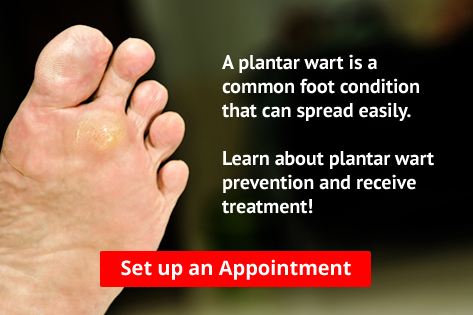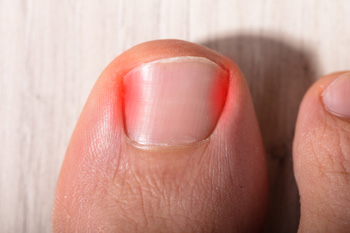August 2019
Plantar Warts Can Be Treated!
How Do I Know If I Have A Bunion?
 The most noticeable symptom of a bunion is a large bony protrusion on the side of the big toe. It is considered to be a bone deformity, and can occur as a result of genetic factors, or from wearing shoes that do not have adequate room for the toes to move freely in. It can cause the big toe to gradually move toward the other toes, and it may become difficult to wear shoes. Many patients purchase larger size shoes to attain comfort, in addition to wearing bunion pads which may help to ease any friction that may be present. Additional reasons for this condition to occur can include having low arches, injuries that have happened to the feet, or medical conditions such as rheumatoid arthritis. Some of the symptoms that are associated with this ailment can consist of pain and discomfort surrounding the affected area, the formation of corns and calluses on top of the bunion, and it may be difficult to move the toe. If you have a bunion, it is advised that you consult with a podiatrist who can recommend correct treatment options, which may include surgery for permanent removal of the bunion.
The most noticeable symptom of a bunion is a large bony protrusion on the side of the big toe. It is considered to be a bone deformity, and can occur as a result of genetic factors, or from wearing shoes that do not have adequate room for the toes to move freely in. It can cause the big toe to gradually move toward the other toes, and it may become difficult to wear shoes. Many patients purchase larger size shoes to attain comfort, in addition to wearing bunion pads which may help to ease any friction that may be present. Additional reasons for this condition to occur can include having low arches, injuries that have happened to the feet, or medical conditions such as rheumatoid arthritis. Some of the symptoms that are associated with this ailment can consist of pain and discomfort surrounding the affected area, the formation of corns and calluses on top of the bunion, and it may be difficult to move the toe. If you have a bunion, it is advised that you consult with a podiatrist who can recommend correct treatment options, which may include surgery for permanent removal of the bunion.
If you are suffering from bunions, contact Dr. Craig Campbell of Salt Lake City, Utah. Our doctor can provide the care you need to keep you pain-free and on your feet.
What Is a Bunion?
A bunion is formed of swollen tissue or an enlargement of boney growth, usually located at the base joint of the toe that connects to the foot. The swelling occurs due to the bones in the big toe shifting inward, which impacts the other toes of the foot. This causes the area around the base of the big toe to become inflamed and painful.
Why Do Bunions Form?
Genetics – Susceptibility to bunions are often hereditary
Stress on the feet – Poorly fitted and uncomfortable footwear that places stress on feet, such as heels, can worsen existing bunions
How Are Bunions Diagnosed?
Doctors often perform two tests – blood tests and x-rays – when trying to diagnose bunions, especially in the early stages of development. Blood tests help determine if the foot pain is being caused by something else, such as arthritis, while x-rays provide a clear picture of your bone structure to your doctor.
How Are Bunions Treated?
- Refrain from wearing heels or similar shoes that cause discomfort
- Select wider shoes that can provide more comfort and reduce pain
- Anti-inflammatory and pain management drugs
- Orthotics or foot inserts
- Surgery
If you have any questions, please feel free to contact our office located in Salt Lake City, UT. We offer the newest diagnostic and treatment technologies for all your foot care needs.
Read more about What Are Bunions?Flat Feet and Babies
 When babies are born, the foot bones have not fully developed, and the feet are generally flexible. It is beneficial for toddlers to walk barefoot while indoors, because this helps the feet to become strong as the toes grasp the floor. When shoes are worn outside, they should fit correctly, and be constructed of a breathable material. It is beneficial to measure your child’s feet every three months up to age three. This is helpful in choosing the correct size shoes, which should have adequate room for the toes to move freely in. Flat feet is a common condition that babies are born with, and will typically outgrow by the age of seven. If you notice your child is walking with their toes pointed inward or outward, it is suggested to schedule a consultation with a podiatrist who can properly diagnose any foot condition.
When babies are born, the foot bones have not fully developed, and the feet are generally flexible. It is beneficial for toddlers to walk barefoot while indoors, because this helps the feet to become strong as the toes grasp the floor. When shoes are worn outside, they should fit correctly, and be constructed of a breathable material. It is beneficial to measure your child’s feet every three months up to age three. This is helpful in choosing the correct size shoes, which should have adequate room for the toes to move freely in. Flat feet is a common condition that babies are born with, and will typically outgrow by the age of seven. If you notice your child is walking with their toes pointed inward or outward, it is suggested to schedule a consultation with a podiatrist who can properly diagnose any foot condition.
The health of a child’s feet is vital to their overall well-being. If you have any questions regarding foot health, contact Dr. Craig Campbell of Salt Lake City, Utah. Our doctor can provide the care you need to keep you pain-free and on your feet.
Tips for Keeping Children's Feet Healthy
- Make sure their shoes fit properly
- Look for any signs of in-toeing or out-toeing
- Check to see if they have Clubfoot (condition that affects your child’s foot and ankle, twisting the heel and toes inward) which is one of the most common nonmajor birth defects.
- Lightly cover your baby’s feet (Tight covers may keep your baby from moving their feet freely, and could prevent normal development)
- Allow your toddler to go shoeless (Shoes can be restricting for a young child’s foot)
- Cut toenails straight across to avoid ingrown toenails
- Keep your child’s foot clean and dry
- Cover cuts and scrapes. Wash any scratches with soap and water and cover them with a bandage until they’ve healed.
If you have any questions, please feel free to contact our office located in Salt Lake City, UT. We offer the newest diagnostic and treatment technologies for all your foot care needs.
Read more about How to Care for Your Child's FeetIngrown Toenails Can Cause Pain
The symptoms of an ingrown toenail can be quite noticeable. They typically consist of red and swollen skin on the sides of the big toe, and it generally causes pain and discomfort. It can occur as a result of wearing shoes that do not fit properly, and this can possibly cause the toenail to grow into the surrounding skin. If your child has an ingrown toenail, they may find mild relief when the affected toe is soaked in warm water. This may help to move the swollen portion of skin away from the nail. It may be beneficial to wear sandals as the healing process occurs, and this can help to keep pressure off of the nail. If you are afflicted with an ingrown toenail, it is strongly advised that you seek the counsel of a podiatrist who can properly treat this condition.
Ingrown toenails may initially present themselves as a minor discomfort, but they may progress into an infection in the skin without proper treatment. For more information about ingrown toenails, contact Dr. Craig Campbell of Salt Lake City, Utah. Our doctor can provide the care you need to keep you pain-free and on your feet.
Ingrown Toenails
Ingrown toenails are caused when the corner or side of a toenail grows into the soft flesh surrounding it. They often result in redness, swelling, pain, and in some cases, infection. This condition typically affects the big toe and may recur if it is not treated properly.
Causes
- Improper toenail trimming
- Genetics
- Improper shoe fitting
- Injury from pedicures or nail picking
- Abnormal gait
- Poor hygiene
You are more likely to develop an ingrown toenail if you are obese, have diabetes, arthritis, or have any fungal infection in your nails. Additionally, people who have foot or toe deformities are at a higher risk of developing an ingrown toenail.
Symptoms
Some symptoms of ingrown toenails are redness, swelling, and pain. In rare cases, there may be a yellowish drainage coming from the nail.
Treatment
Ignoring an ingrown toenail can have serious complications. Infections of the nail border can progress to a deeper soft-tissue infection, which can then turn into a bone infection. You should always speak with your podiatrist if you suspect you have an ingrown toenail, especially if you have diabetes or poor circulation.
If you have any questions, please feel free to contact our office located in Salt Lake City, UT. We offer the newest diagnostic and treatment technologies for all your foot care needs.
Read more about Ingrown Toenail Care







